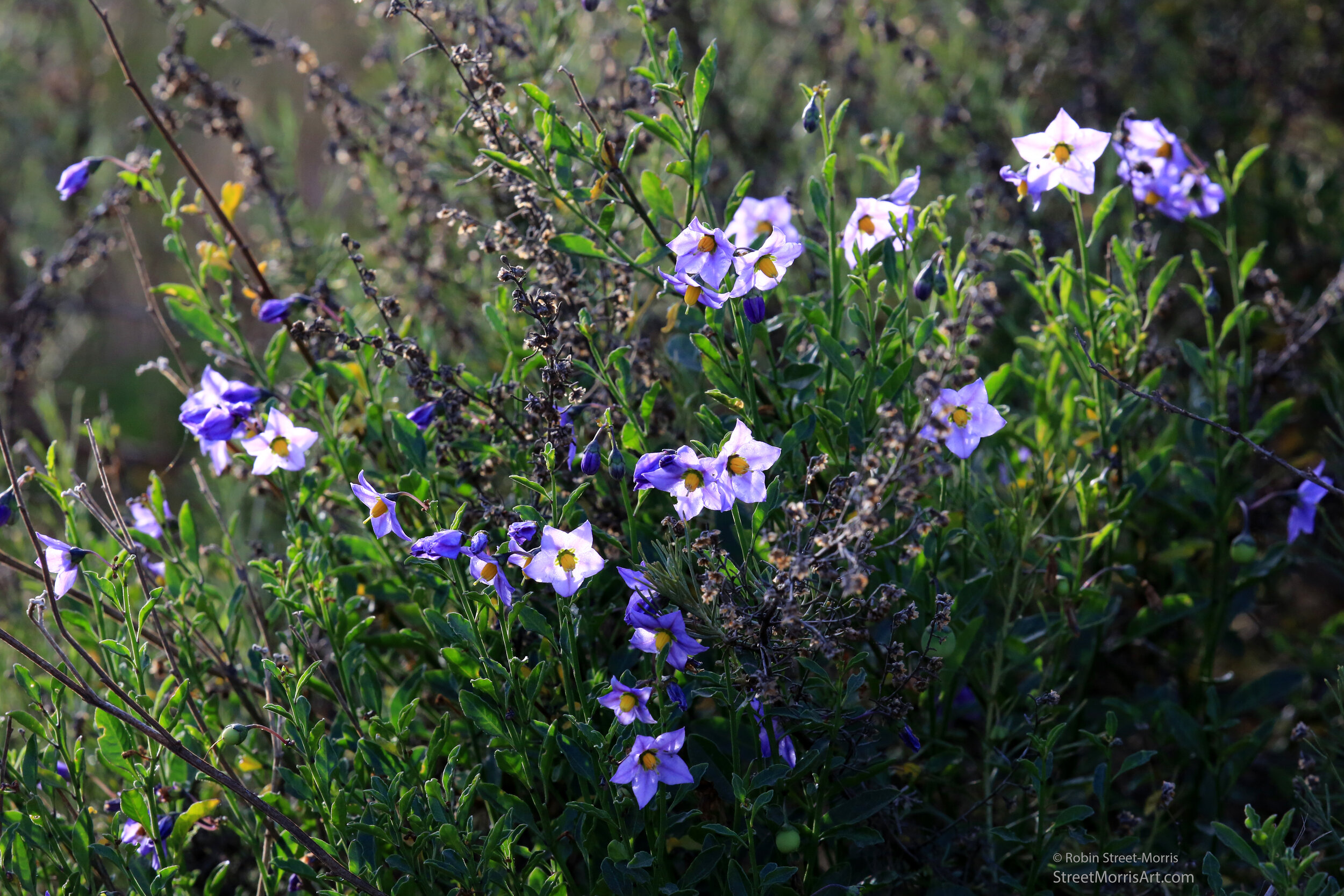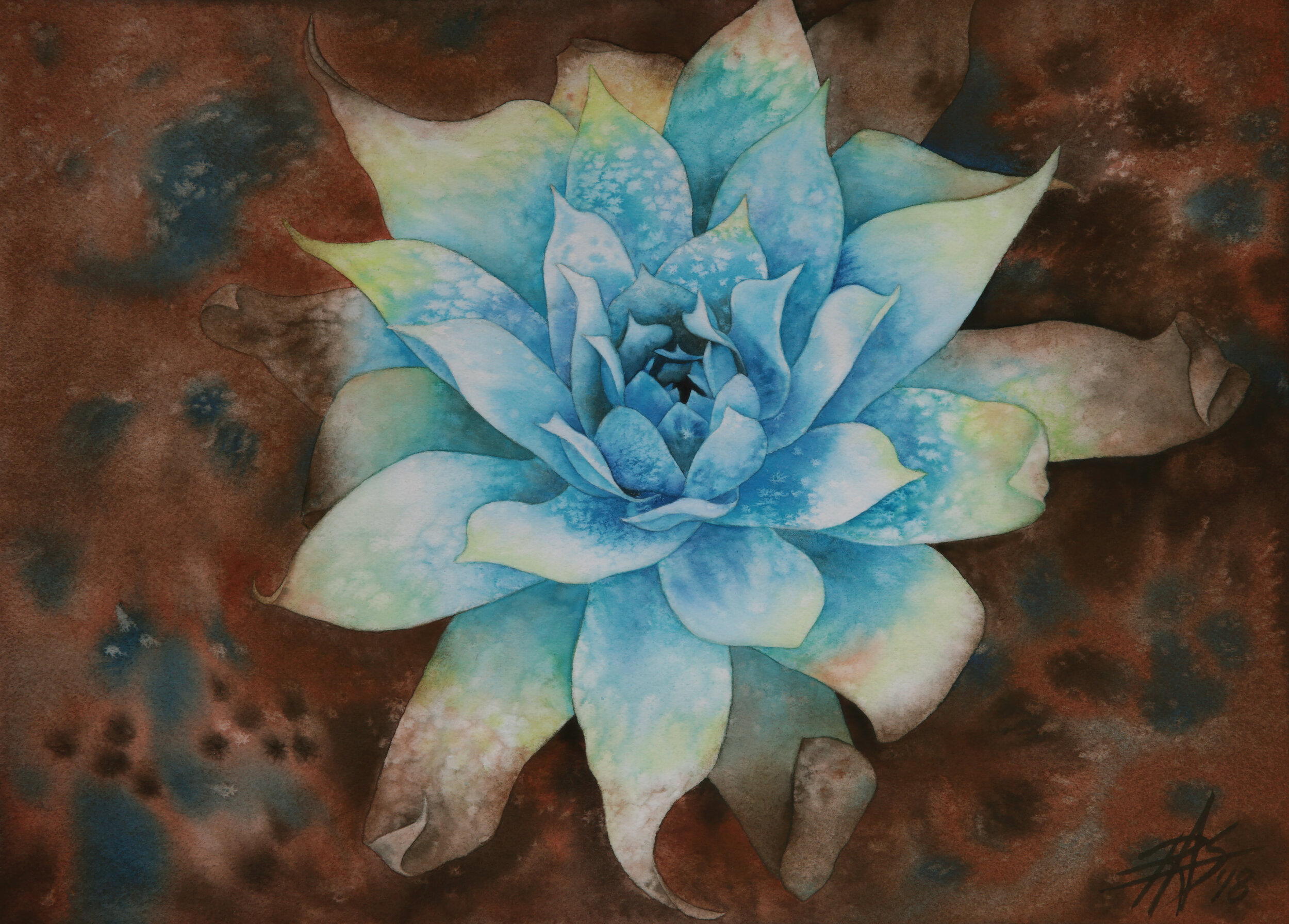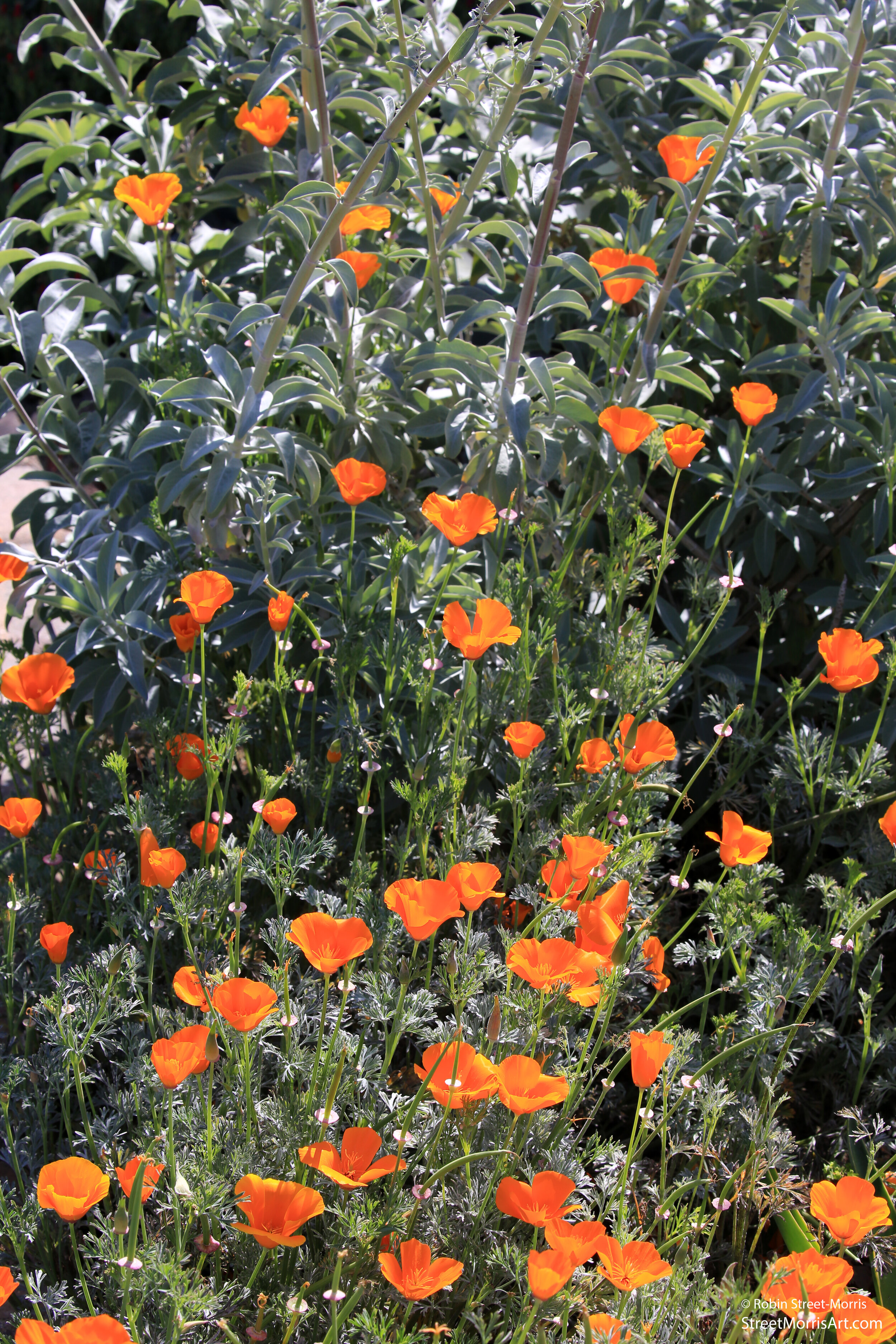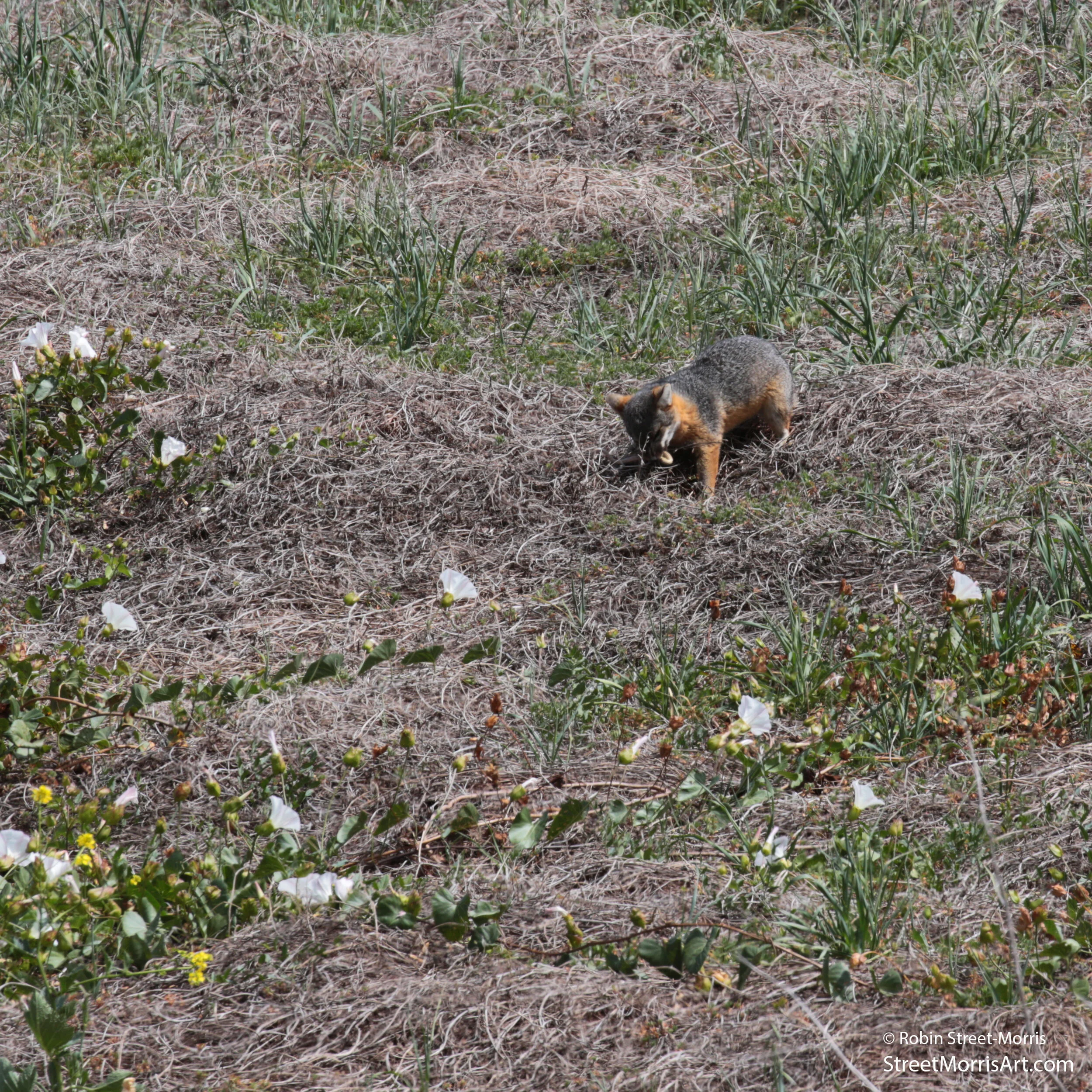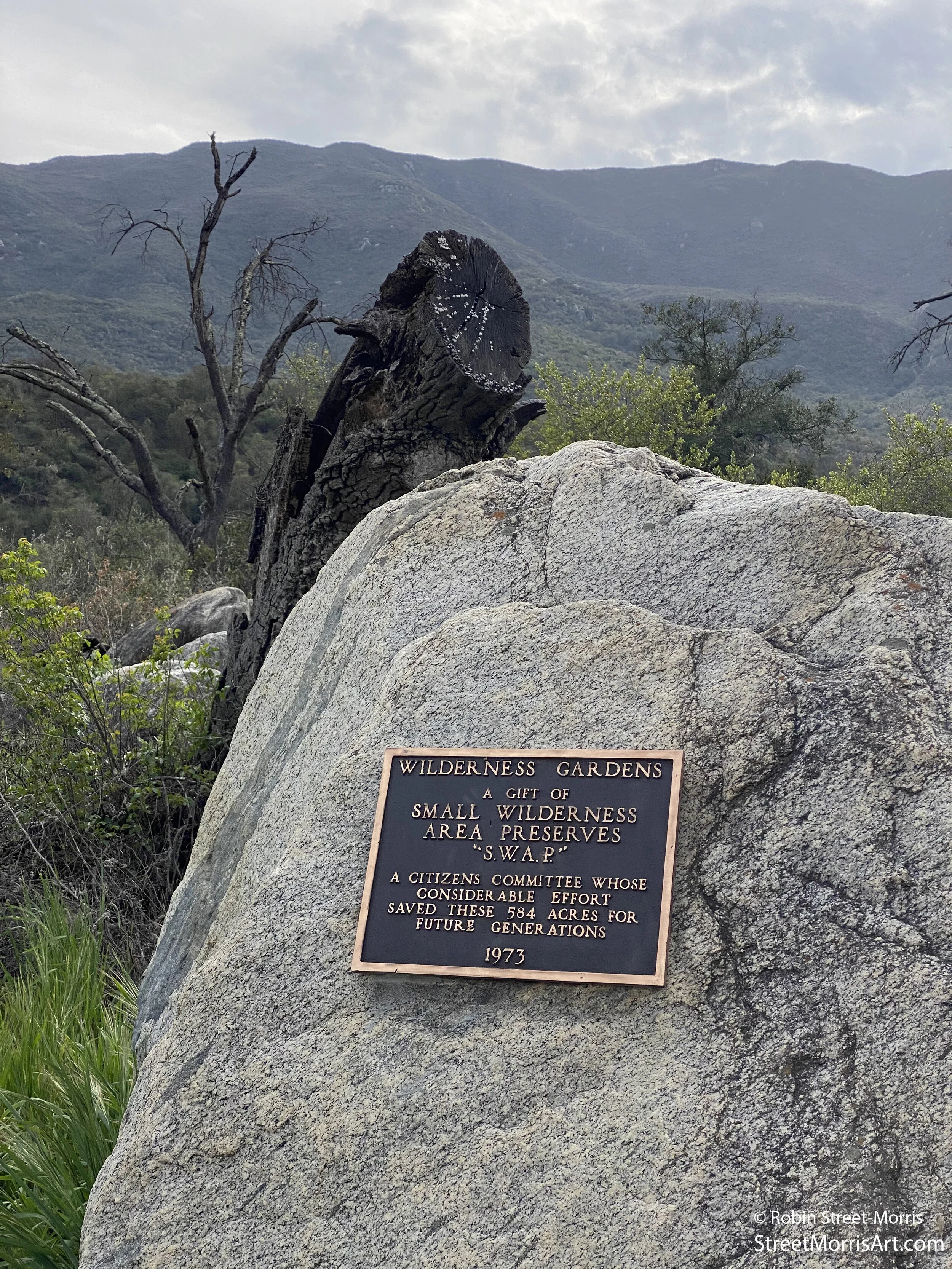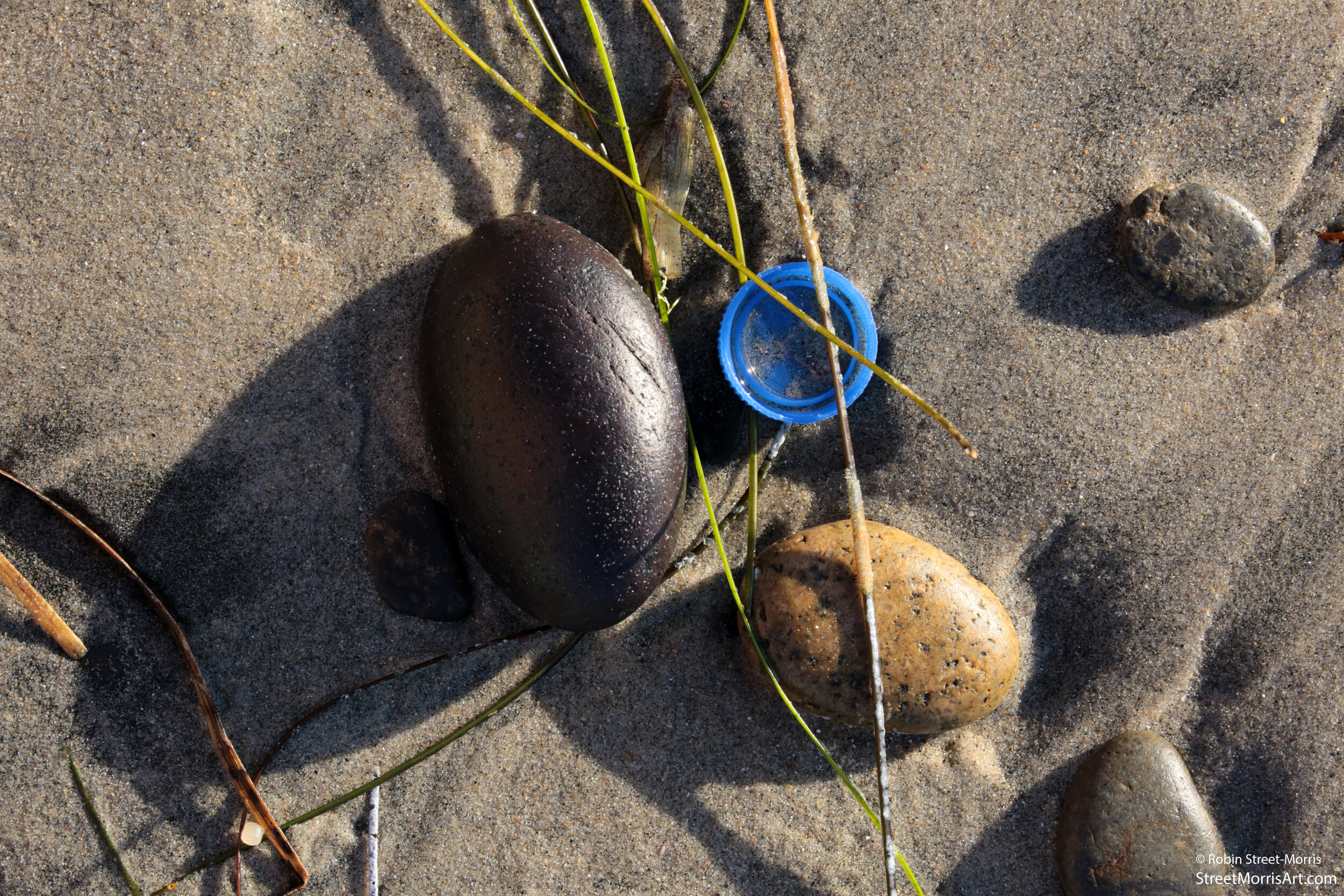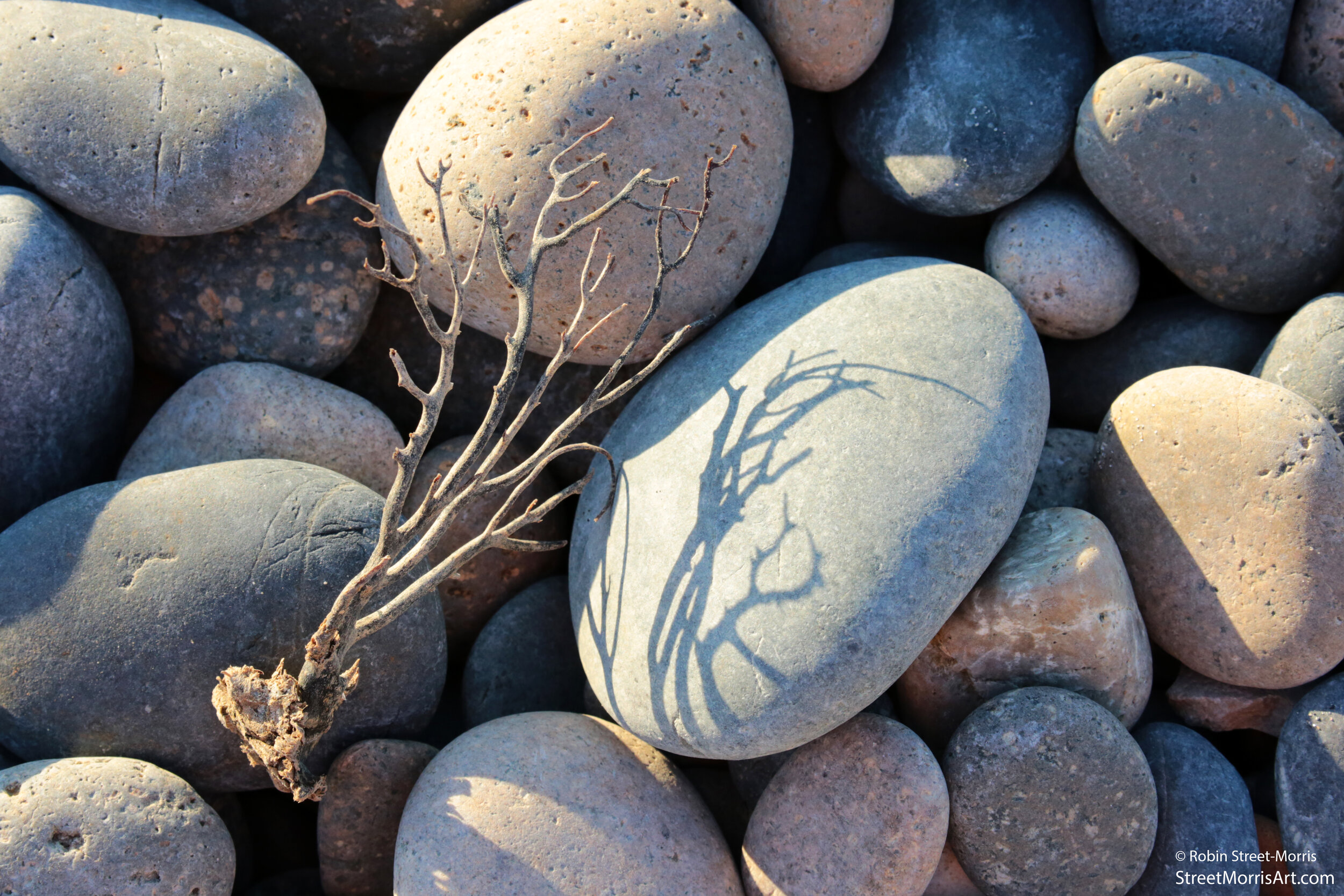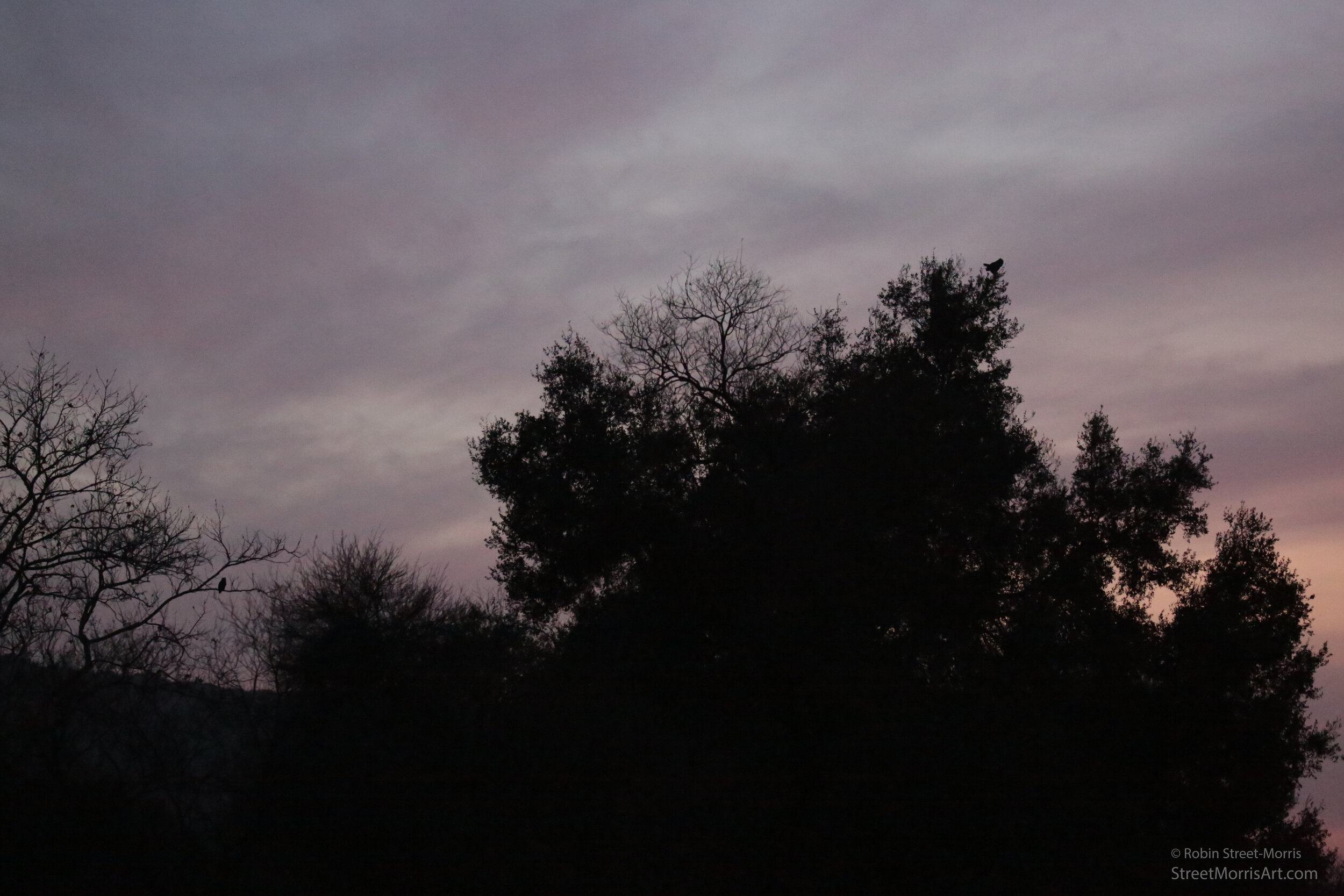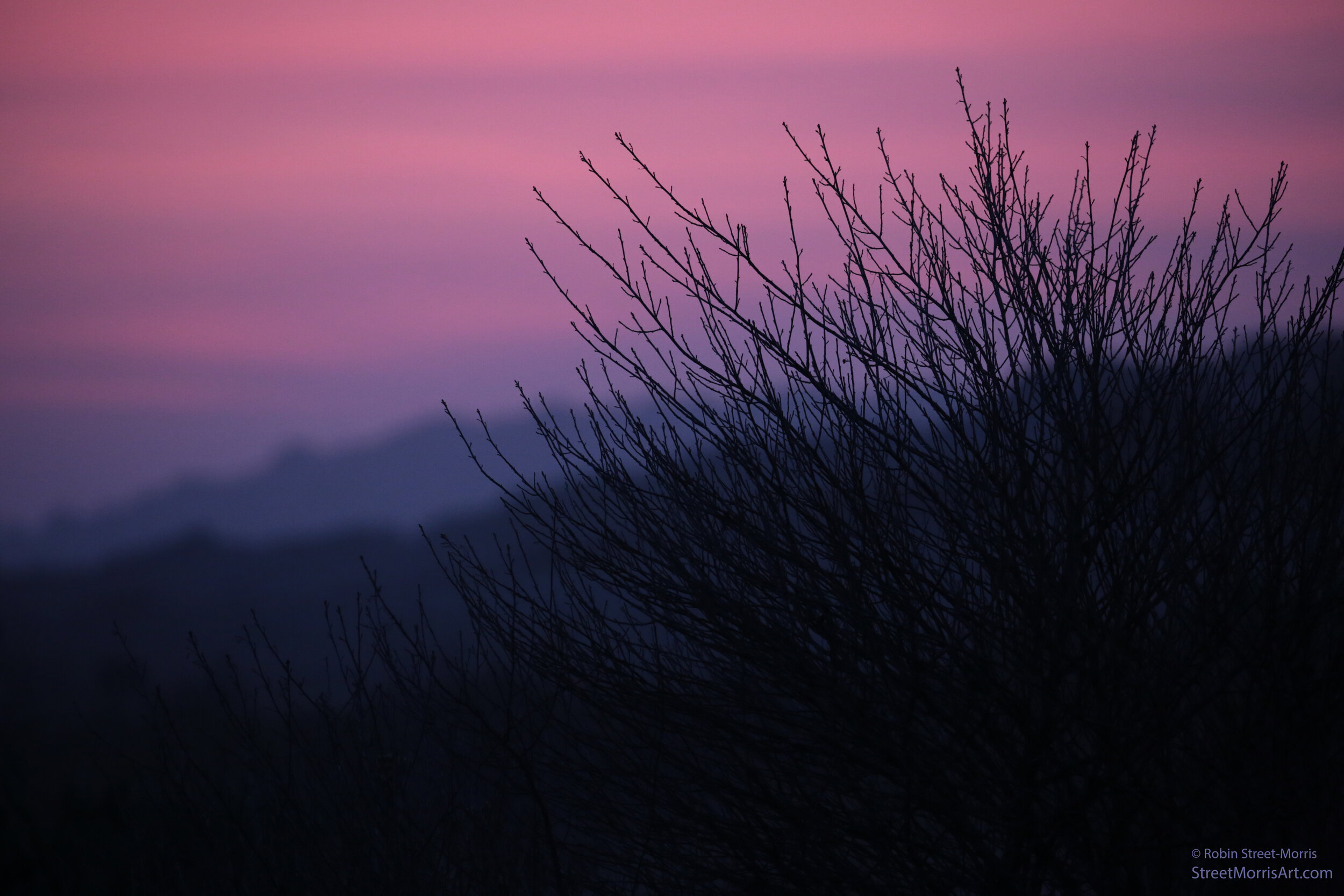It hurts to watch organisms we love dearly die, particularly when it wasn't their time to go. And it’s difficult to be in the company of people who don't accept that anthropogenic climate change is the real deal.
Mule deer family in the yard
Hi there.
The Stare (Owl Moon VI)
Halloween is a summer away, but any time of year is a good time for me to celebrate two of my favorite things: owls and the Moon. This is a long running series that I return to when I feel like it. I recently took note of the boxes of Prismacolor pencils in my studio closet that hadn’t been touched in years and thought why not? There are less used colors in there from high school (cringe).
While I obviously took a lot of artistic liberty with it, this mixed media piece was inspired by an actual owl encounter in Tecolote Canyon. If you live in San Diego, you may know that this lovely park is on the other side of the 5 from Mission Bay and Sea World. I plan on paying a pair there a visit today and seeing if I can’t find an owlet or two. They were definitely nesting when this male eyed me sternly.
California Native Plant Week
Homeowners nearby got California Native Plant Week started a little early by having a magnificent laurel sumac chopped down. I'd have been thrilled had it come with our house purchase instead of the acacias and ecosystem-altering saltcedar that's since been replaced with a bush rue. I'm hoping our immediate neighbors don't feel pressured to do the same with their lemonade berry; it's trimmed up into an open shape the fire department feels is acceptable for creating a defensible space and isn't going to be responsible for our homes burning down if disaster hits this canyon. Palm fronds grazing our homes’ roofs and embers landing in leaf-filled gutters are another story. Those things are easily addressed without leveling more habitat and making our views hideous, though the powers that be already accomplished the latter at least somewhat by festooning the canyon finger with colored tape last fall urging us to do the former.
I dried my eyes, blew my nose and headed down to Los Peñasquitos Canyon Preserve to escape the sounds of the chainsaws that were giving me chills and to remind myself of what made me want to live in this area in the first place.
Peñasquitos Creek riparian zone
Mountain lion snacks doing some pruning
It and other discarded masks left with me along with the usual wrappers and plastic bottles.
Parish's nightshade (Solanum parishii)
Coast prickly pear (Opuntia littoralis)
Sycamore and willow holding paws
I learned that our San Diego chapter of the California Native Plant Society is to have a new mascot based on Dudleya pulverulenta. I could have painted one at its plumpest, but liked the contrast of the curled leaves and lush center of this one. It shows how well adapted they are to surviving our dry season while remaining beautiful. The inspiration for this piece is growing near a narrow path that dips low next to a bridge that’s part of a multiuse trail in Los Peñasquitos Canyon Preserve. One day, I was standing in said spot photographing it and a guy on a mountain bike shouted down to me asking if I was going to move any time soon. He wanted to take the more challenging way down rather than riding across the bridge. I told him pleasantly that I wasn’t finished and that the path I was on is for pedestrians and equestrians. He retorted that he didn’t see any horses. I suggested he ride across the bridge which he proceeded to do while calling me a few choice words women tend to not appreciate. I’ve learned that trail usage signs do little to stop cyclists out there and that if I stand my ground on the pedestrian/equestrian trails they ride around me into the plants, so I’ve given up on that approach.
Wherever we rest our heads the vast majority of nights is our home. Unless we’re camping (or homeless), we leave the preserves and parks and return to our apartments, condos and houses at night. The plants and animals in them have nowhere else to go, thus it’s my opinion that we owe them the right of way when we’re in their home.
California poppies (Eschscholzia californica) and white sages (Salvia apiana) are putting on a show in our yard as are many other sages and wildflowers.
Island fox "hunt"
What I'm most hoping for when I visit Channel Islands National Park is to see these pint-sized apex predators thriving in their home and ignoring us. The ranger who met us at the pier for orientation mentioned that some of the foxes are so tame they'll get up on the picnic tables to join us for lunch. My husband knows how much I love them and wondered aloud what my reaction would be if one hopped up next to me and begged. As tempted as I might be to make a little friend for the moment, I would not share my food with an island fox. Everything I’ve read about them has taught me that it's in their best interest to forage for native fruits and hunt insects, island deer mice and reptiles. Even snakes.
This fox was wandering around the campground sniffing for dropped snacks and sat down in the sun before curling up to take a short nap as I came closer. It got up again after it drew a larger crowd.
One person wondered aloud if it was breathing.
After walking about a mile from the campground into Scorpion Canyon, I caught sight of alert, cinnamon-colored ears glowing high on the canyonside. Unlike our fox sighting on Santa Rosa Island, we had more time to linger and observe its behavior without fear of missing the boat back to Ventura.
These are heavily cropped 400mm shots of it hunting a snake, quite likely a Santa Cruz Island gophersnake judging by its slightly spotted underside, but I can't say for certain. It cached its prey after biting it behind its neck while shaking it furiously and then continued hunting. There's quite likely a den nearby with fox kits on the way given the time of year.
Santa Cruz Island fox (Urocyon littoralis subspecies santacruzae ) spotted!
Prey located…
The pounce!
Even shooting at 1/400 second, its forehead and ears are ablur here because it was shaking that snake so hard.
You might be able to see faint markings on the unfortunate snake’s underside if you’re checking out this post on a quality monitor.
It appeared to nibble for awhile and then cache its kill.
The hunt continues.
The recovery of this species is a conservation success story and you can read about it here if you're unfamiliar with it. If you'd like to help continue research efforts, consider sending Friends of the Island Fox a few bucks.
Santa Cruz Island has inspired a number of my mixed media paintings. Clicking or tapping on the images of them below will take you to prints of them at Pixel.com.
A flying jewel
I spent some time today appreciating the peridot sweat bees (Augochlorella pomoniella) and other pollinators moving between plants blooming in our garden. There are over 20,000 different species of known bees in the world. They’re all of intrinsic value and important to humanity’s survival as well.
Augochlorella pomoniella working Leptosyne maritima
They were interested in Echinocereus triglochidiatus as well. Claretcup cactus (just one of its many common names) is a favorite of mine. The blossoms look like embers when one catches them backlit.
Northern harrier
I'd have thought I was watching a short-eared owl hunting if I didn't know our birds of prey fairly well. Their methods are similar and northern harriers have a pretty flat, owlish face for a hawk. They seem to really like Lopez Canyon which connects to our canyon and don't appear to be as bothered by the established invasive mustard as I am. An enormous striped skunk was foraging busily nearby and the hawk did take a brief look, but who in their right mind would tackle that?!
This would make a fitting profile shot for me if I were still able to stomach social media.
Long Shadows in Lopez Canyon. Transparent watercolor and powdered soft pastel on 300lb hot press paper. 15" x 19" (38 x 48cm).
Here’s a slope cleared for the purpose of creating defensible space for a home backing up to Los Peñasquitos Canyon Preserve. Nature abhors a vacuum and the invasive plants that renew annually take hold and reseed heavily when we don’t stay ahead of them. I spend more time than I’d like weeding in order to keep the worst of them at bay. At least it’s “yoga” in the company of wildlife with the scent of my Cleveland sages and others nearby to cheer me on.
I can’t mention Hawaiian short-eared owls without including a shot of one soaring within a Haleakalā National Park cloud. These are moments one never forgets.
Can't live on nectar alone
If you observe Anna’s hummingbirds for awhile, you'll see them collecting spider webs and lichens for their nests, picking insects off of plants and even catching them midair with all of the maneuvers you'd expect from birds capable of flying backwards. They're the only ones who can do that without help from wind. I recently paused along Peñasquitos Creek one evening to watch this male adding some protein to his diet.
Nesting out back in the big Peruvian peppertree is another Anna's. It's the one plant on the slope I didn't replace with a local native. All of my plantings are doing great with many sages and bladderpod already in flower to nourish the hummingbirds and others. I hope she and her young luck out with the invasive Argentine ants. A nesting attempt on our property line last year ended with the hatchlings being swarmed shortly after the eggs hatched. The California Argentine ant supercolony thrives on our addiction to incessant irrigation.
A few moments in Wilderness Gardens County Preserve
This is a species that results in muffled squeals when I find one. Everything about it is beautiful in my opinion. I wasn’t exactly thrilled with myself for having left my macro lens at home.
California Peony (Paeonia californica)
Kumeyaay Ehmuu (Bedrock Mortar) with Oak Leaf and Acorn
These are used by native people to grind acorns and other foods.
Discarded Butt
If this action had resulted in an inferno, would it really have been a “wildfire?” Careless arson is more like it. And the native plant “fuel” would be blamed.
Blue Dicks (Dichelostemma capitatum) with Buffalo Gourd (Cucurbita foetidissima)
Coyote Stare
It was a brief encounter and wonderful as always. Coyotes who aren’t fed by humans will be out of sight shortly after you see them.
Fingertips (Dudleya edulis) and Chaparral Yucca Remains (Hesperoyucca whipplei)
I planted this very combination in our backyard years ago and both have become huge. Sea dahlias (Leptosyne maritima) have woven themselves through the chaparral yucca and are currently blooming; the latter will send up a large inflorescence at some point, bloom profusely and then die. Sculptural hardly covers it.
A heartfelt thank you to the people who saved this land for the native plants, wildlife and us to enjoy respectfully. Some “things” are irreplaceable.
Wave-formed still lifes at Torrey Pines State Beach
Spiny Mole Crab Carapace and Pacific Sea Gooseberries
Syringe
Chip Bag and Giant Kelp
Eccentric Sand Dollar
Hook
Microplastic
Weathered Straw and Pacific Sea Gooseberries
Bottle Cap
Wing
T-End Fabric Fastener
Bones
A new piece and an exhibition announcement
My latest mixed media painting.
Juror Paul Glenshaw of the Smithsonian Institution selected two of my landscape paintings for inclusion in the 2021 Art on Paper exhibition at Maryland Federation of Art’s Circle Gallery in Annapolis, Maryland. This was one of those times when I found myself admiring every piece included in the show as I scrolled through the gallery of accepted work.
As is typically the case, the paintings I’ll be carefully matting and framing to send across the country were inspired by personal moments in nature.
Fragrant evening-primrose (Oenothera cespitosa)
This is the first one of the year with more blossoms on the way. I’m thinking of placing my camera trap facing the next round of buds when I see them beginning to open. Maybe I’ll catch one of its pollinators, the spectacular white-lined sphinx moth. This species isn’t native to the coast, but I couldn’t resist it. It’s well-behaved in the garden and I pluck spent blooms.
A white-crowned sparrow's last sunrise
At least he didn’t know the Cooper’s hawk was coming (not for long, anyway). I witness predation events pretty frequently around here. My only wish, since the hawks need to eat as well, is that Artemis would show up a bit more quickly to dispatch prey with her painless arrows, but that’s not how the natural world really works.
The yard has been purposefully turned into a bird garden. There’s a lot of evergreen cover for passerines to hide in when flushed, so the raptors aren’t always successful. For levity’s sake, I’ll share that I felt one of these birds bomb so close to my head while I was planting a native buckwheat at dusk last week that I felt its beating wings over my head. It spared me its talons, no doubt realizing that my bouncing ponytail as I wielded my hori-hori wasn’t one of the California ground squirrels living below the fence after all.
Los Peñasquitos Canyon Sunrise with Mount Laguna
Cooper’s Hawk with White-Crowned Sparrow
Her Desher
In anticipation of Perseverance landing safely on Mars today, I headed back in time with this mixed media piece I made in 2004 titled Her Desher, as "the red one" was known in ancient Egypt. I’ve made quite a bit of celestial-inspired art since my days of watching the shuttle launches and playing with my space LEGO. There’s very little indication that I’ll be growing out of this behavior. And I still have said LEGO in case I feel the urge to celebrate that way.
Mars made a more recent appearance in The Conversation. It was visible above a moon cast red by a climate fire in San Diego's East County. The crows are locals who had paid a visit to the back fence that afternoon while I watched the smoke billow.
Gray whales and Mylar balloons
San Diego is located along the eastern North Pacific gray whale population's migration route between their Baja breeding and summer feeding grounds in the Arctic. A perfect day of mine is sitting on a bench along the Guy Fleming trail at Torrey Pines State Natural Reserve and watching them swim by with my binoculars in hand or going out to see them from the vantage point of a boat. My latest piece was inspired by a sighting of a healthy cow and her newborn calf while on the Privateer with San Diego Whale Watch. She clearly didn't make it to the nearby birthing lagoons in Mexico. Said species is in the midst of an unusual mortality event, so it was particularly uplifting to see this pair of whales doing well.
And, of course, there were the usual Mylar balloon sightings. I get it. They're shiny and the perfect last minute party touch we spot while checking out at the grocery store. I've seen so many floating on the water and stuck in trees and powerlines that I must admit to fantasizing about popping every last one of them while standing in line. That action would likely earn me a court date unlike the manufacturing of these sea turtle chokers that look like jellyfish once the paint sloughs off. But that's how our society works, right? If you must buy these balloons, please pop them and put them in the trash once the festivity is over in an attempt to keep them from entering the food chain.
They’re doing it right with limited capacity.
Acorn Woodpecker with starling flight
European starlings aren’t native to this country, but I appreciate them anyway. Their beautiful murmurations are grand enough to make the news at times. This photograph captured a more subtle flight. At the far left you can see an acorn woodpecker watching them jockeying for position among the branches of a California sycamore filled with woodpecker nest cavities.
Bromeliad visitor
Nature to the rescue
This isn’t the same pair of great horned owls as was shown mating in a recent post of mine. They also live in Los Peñasquitos Canyon Preserve here in San Diego about a mile west of the others, though I suppose they’re still slumming it in the eyes of some owls since they live east of the 5. Years ago, I was able to come to the conclusion that this isn’t the same pair as the other one by being present for their evening wake up routines at the same time on different days on multiple occasions. I'd not visited this pair in awhile. Their territory is farther from the house with a rockier walk up and out left to contend with in the dark which was done last night while listening to the hauntingly beautiful sound of howling coyotes. I also try to see the closer pair more often because I’d like to figure out where they choose to nest, if indeed they do, and if it’s in a spot I can observe without venturing off trail or onto private property.
We were fortunate to see this male sail silently over our heads and land in a distant tree where he began hooting to his mate. She flew out from deep in the woods along the creek to a spot in a bare California sycamore. They followed each other into inaccessible darkness after a brief duet.
This is the male great horned owl. He has deeper hoots than she does.
That’s the female.
Zooming out, you can see them in their respective perches here. I was shooting with a 100-400mm telephoto lens and keeping my distance from them so as not to impact their behavior.
It left with me.
With so little else open during this pandemic, our local preserves and state parks are getting even more trashed than usual. These spaces were set aside first and foremost to protect the remnants of what was here after people began bulldozing land for our sprawling homes, office parks and large scale agriculture. It’s possible to recreate in them and celebrate their beauty while treating them with respect, but that requires thinking about the consequences of our actions. Discarding plastic, cigarette butts and tearing up narrow trails made more fragile by winter rains and heavy fog threatens the plants and wildlife that live within these areas. They have no other homes to retreat to.
Happy New Year. Thanks for your continued emotional and financial support of living artists, any living artist. I’d say 2021 can’t be any worse than what we’ve just experienced, but entropy is clearly still a thing.
—Robin Street-Morris
Happy Winter Solstice!
California kingsnake
I was thrilled to see this California kingsnake (Lampropeltis californiae) heading across a trail in Los Peñasquitos Canyon Preserve. Had I not been looking down, I could have easily stepped on it or put the front wheel of one of my bikes across its back. Flattened animals and plants are situations I encounter in our San Diego preserves all too often. I stuck around until it made its way safely across.







